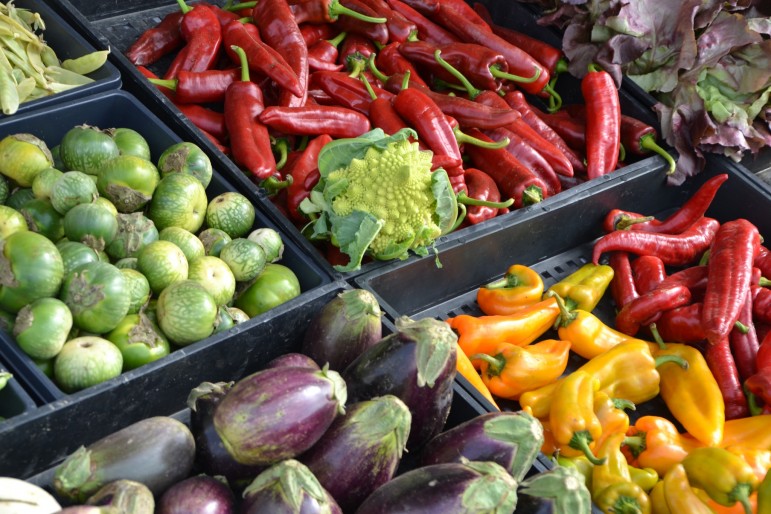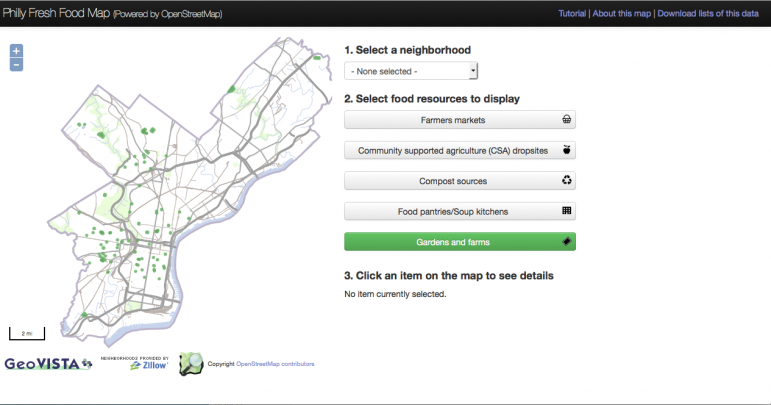
Farm stand produce might go unrecognized if the right people don’t map it. Image: Flickr, Suzie’s Farm
By Marie Orttenburger
With some extra passion and determination, an online map of healthy food sources in Philadelphia’s low-income communities could also be an important tool for food initiatives in the Great Lakes region.
Maps that show the locations of farmers markets aren’t uncommon. Cities and organizations continue to publish and maintain them.
But the information that populates them often comes from one source, such as a city database of licensed farmers markets or is limited by the interests of the authoring organization, said Sterling Quinn, a doctoral student in geology at Pennsylvania State University and creator of the Philly Fresh Food Map.
They leave out important locations, which can limit access to locally grown food, Quinn said. “All map makers have to make choices about what they put in their map.”
The Philly Fresh Food Map was created by members of the Philadelphia community with open source software called OpenStreetMap. Anyone with basic training can add to the map, resulting in a collaboratively curated resource.
Quinn’s case study on the project, co-authored with Lakshman Yapa and published recently in The Professional Geographer, says that the map’s value is that it is free and that the public can edit it.
“It opens the doors for things that might not be represented in institutionally produced maps,” Quinn said. That could include important sources of food like a roadside fruit stand or a church’s basement food pantry.
This is important for organizations like the Heartside Gleaning Initiative in Grand Rapids, Michigan. The initiative connects donors of healthy food to low-income individuals in the Heartside neighborhood.
Because many of its clientele lack computers or smart phones, Heartside depends
entirely on word of mouth to make sure people know when and where to get food, said Lisa Sisson, who chairs the initiative. That means it’s extra important to make sure that organizations that can spread the word know when and where to find healthy food.
“Getting the word out is a very difficult thing for us,” Sisson said.
Heartside advertises at some local low-income housing, but going through other organizations to keep information updated can be a headache, Sisson said. So while individual consumers might not be able to access online maps, the organizations that connect low-income individuals with healthy food resources would benefit from a resource that they can add to and keep updated.
“I see more helpers using it than clients,” Sisson said. A free referral and information hotline supported by the United Way “might use it a lot.”
Starting such a map is difficult.
In Philadelphia, Quinn hosted a “map-a-thon” where people in the local food and technology communities filled it out together. But he has struggled with getting residents to continue updating it after the map-a-thon ended.
Homegrown Minneapolis, a citywide initiative promoting local food production and access, had similar problems getting people to map locations of urban farms. The map was promoted directly to farmers and through listservs, but wasn’t terribly successful, said Tamara Downs Schwei, the local food policy coordinator for the group.
Downs Schwei attributed the problem to farmers not seeing the advantage of adding their resources to the map.
“It takes a buy in and investment from the community for them to participate,” Downs Schwei said.
Quinn thinks that what his map needs is people who are passionate about the project – whether they’re in it to learn about digital mapping or to promote access to local food.
“A lot of people aren’t as excited about digital maps and technology as I am,” Quinn said, “but they are interested in food resources in their neighborhood.
“We just need to connect the right people to get the information out.”
